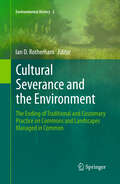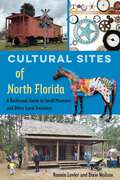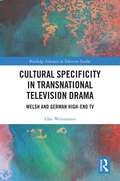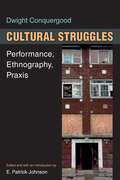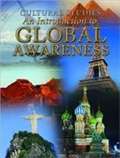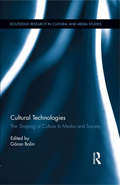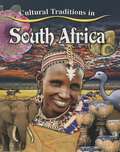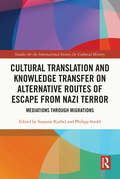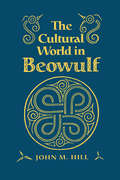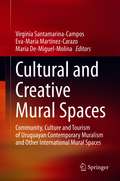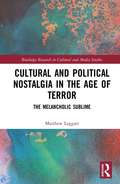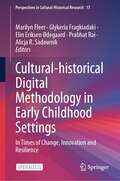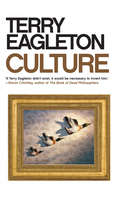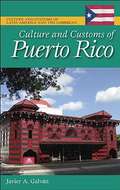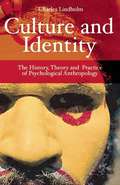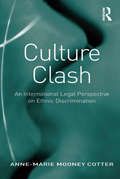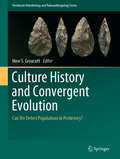- Table View
- List View
Cultural Sanctification: Engaging the World like the Early Church
by Stephen O. PresleyHow to keep faith in a culture hostile to Christianity In an increasingly secular world, Christians are often pulled in two directions. Some urge us to retreat and build insular communities. Others call upon us to wage a culture war, harnessing the government to shore up Christian cultural power. But there is another way—and it&’s as old as the church itself. Stephen O. Presley takes us back to the first few centuries AD to show us how the first Christians approached cultural engagement. Amid a pagan culture that regarded their faith with suspicion, early Christians founded a religious movement that transformed the ancient world. Looking to great theologians like Augustine, Origen, and Tertullian, Presley shows how the early church approached politics, family, public life, and more. From these examples, he draws lessons for practicing authentic, pious discernment in how we engage with the wider culture. The Christians who came before us endured persecution to share a vision of human flourishing that changed the world. Following in their footsteps, we can sanctify our society through social witness. Readers anxious about shifting cultural tides will be left with hope in the already-present kingdom of God and the promised resurrection.
Cultural Severance and the Environment: The Ending of Traditional and Customary Practice on Commons and Landscapes Managed in Common (Environmental History #2)
by Ian D. RotherhamThis major book explores commons, lands and rights of usage in common, traditional and customary practices, and the cultural nature of 'landscapes'. Importantly, it addresses now critical matters of 'cultural severance' and largely unrecognized impacts on biodiversity and human societies, and implications for conservation, sustainability, and local economies. The book takes major case studies and perspectives from around the world, to address contemporary issues and challenges from historical and ecological perspectives. The book developed from major international conferences and collaborations over around fifteen years, culminating 'The End of Tradition?' in Sheffield, UK, 2010. The chapters are from individuals who are both academic researchers and practitioners. These ideas are now influencing bodies like the EU, UNESCO, and FAO, with recognition by major organisations and stakeholders, of the critical state of the environment consequent on cultural severance.
Cultural Sites of North Florida: A Backroads Guide to Small Museums and Other Local Treasures
by Ronnie Lovler Dixie NeilsonDiscover local history through less-traveled places that reflect the stories and communities of the region Cultural Sites of North Florida is your guide to 43 intriguing, little-known destinations in the northern part of the Florida peninsula, from Crystal River to Jacksonville. In this book, local experts Ronnie Lovler and Dixie Neilson highlight places that can be reached by a short trip away from the highways and down meandering backroads, inviting you to discover forgotten history, immerse yourself in the stories of diverse communities, and learn what makes this area of the state unique.This book features a selection of small museums, culturally significant sites, nature centers, and parks that many tourists and residents may have never explored. Locations include the Florida Thoroughbred Breeders & Owners Association in Ocala, Morningside Nature Center in Gainesville, Camp Blanding Museum and Memorial Park in Starke, the springs of Gilchrist County, Florida Agricultural Legacy Learning Center near St. Augustine, the A. L. Lewis Museum at American Beach, and many more.For each place, Lovler and Neilson describe what can be found there, the story behind the site, and the importance of the site to the people in the community. Whether you enjoy this book from your favorite cozy armchair or by hitting the road to see these hidden gems for yourself, you will be rewarded with a deeper understanding of the past and present of nearby towns and neighborhoods. And you will be inspired to keep exploring on your own as this book shows there is so much more to investigate!
Cultural Specificity in Transnational Television Drama: Welsh and German High-End TV (Routledge Advances in Television Studies)
by Elke WeissmannCultural Specificity in Transnational Television Drama examines two European television industries: those of Germany and Wales.This book analyses how near‑global shifts towards the fragmentation of audiences, the convergence of media and the transnationalisation of the television industries impact in culturally specific ways. It shows that these larger developments in the industries intersect with specific local histories and cultures, which influence how the changes are experienced and what kind of stories they lead to. Offering a comparative cultural analysis of these two industries and their output, and drawing on a variety of methods which include interviews, analysis of published interviews in the trade and other press, some archival research and textual analysis, this book shows that the global shifts in television impact in locally specific ways, which implies a continuation and indeed exaggeration of existing cultural differences at the same time as we see increasing collaboration, internationalisation and, as a result, also homogenisation between nations.This book presents a unique emphasis on both transnationalising and localising tendencies, highlighting the need to maintain analytical focus on the nation in this supposedly post‑national world. It will be of particular interest to scholars and researchers in contemporary television landscape, literary and film studies, modern languages, philosophy and economics.
Cultural Struggles: Performance, Ethnography, Praxis
by E. Patrick Johnson Dwight ConquergoodThe late Dwight Conquergood's research has inspired an entire generation of scholars invested in performance as a meaningful paradigm to understand human interaction, especially between structures of power and the disenfranchised. Conquergood's research laid the groundwork for others to engage issues of ethics in ethnographic research, performance as a meaningful paradigm for ethnography, and case studies that demonstrated the dissolution of theory/practice binaries.Cultural Struggles is the first gathering of Conquergood's work in a single volume, tracing the evolution of one scholar's thinking across a career of scholarship, teaching, and activism, and also the first collection of its kind to bring together theory, method, and complete case studies. The collection begins with an illuminating introduction by E. Patrick Johnson and ends with commentary by other scholars (Micaela di Leonardo, Judith Hamera, Shannon Jackson, D. Soyini Madison, Lisa Merrill, Della Pollock, and Joseph Roach), engaging aspects of Conquergood's work and providing insight into how that work has withstood the test of time, as scholars still draw on his research to inform their current interests and methods.
Cultural Studies: An Introduction To Global Awareness
by Jones Bartlett Publishers StaffIn the global marketplace, we are all interconnected through the Internet, satellites, and commerce. Understanding how to communicate and work with colleagues from across the globe is critical for your studentsrsquo; future success. That understanding begins with Cultural Studies: An Introduction to Global Awareness.This textbook offers students an overview and insights into cultures around the world. Region by region, it explores how history, geography, religion, economics, and politics combine to create unique and diverse cultures. With this greater understanding of how and why cultures work, students will be able to better interpret trends and events abroad.
Cultural Technologies: The Shaping of Culture in Media and Society (Routledge Research in Cultural and Media Studies)
by Göran BolinThe essays in this volume discuss both the culture of technology that we live in today, and culture as technology. Within the chapters of the book cultures of technology and cultural technologies are discussed, focussing on a variety of examples, from varied national contexts. The book brings together internationally recognised scholars from the social sciences and humanities, covering diverse themes such as intellectual property, server farms and search engines, cultural technologies and epistemology, virtual embassies, surveillance, peer-to-peer file-sharing, sound media and nostalgia and much more. It contains both historical and contemporary analyses of technological phenomena as well as epistemological discussions on the uses of technology.
Cultural Topographies of the New Berlin
by Karin Bauer Jennifer Ruth HosekSince Unification and the end of the Cold War, Berlin has witnessed a series of uncommonly intense social, political, and cultural transformations. While positioning itself as a creative center populated by young and cosmopolitan global citizens, the “New Berlin” is at the same time a rich site of historical memory, defined inescapably by its past even as it articulates German and European hopes for the future. Cultural Topographies of the New Berlin presents a fascinating cross-section of life in Germany’s largest city, revealing the complex ways in which globalization, ethnicity, economics, memory, and national identity inflect how its urban spaces are inhabited and depicted.
Cultural Traditions In South Africa (Cultural Traditions in My World)
by Molly AloianSouth Africa is known as the "Rainbow Nation" because the people who live there have come from many different backgrounds. This fascinating book describes the holidays and family celebrations inspired by the many cultures of South Africa's people. Teacher's guide available.
Cultural Translation and Knowledge Transfer on Alternative Routes of Escape from Nazi Terror: Meditations Through Migrations (Studies for the International Society for Cultural History)
by Susanne KorbelThe book investigates and compares the role of artistic and academic refugees from National Socialism acting as "cultural mediators" or "agents of knowledge" between their origin and host societies. By doing so, it locates itself at the intersection of the recently emerging field of the history of knowledge, transnational history, migration, exile, as well as cultural transfer studies. The case studies provided in this volume are of global scope, focusing on routes of escape and migration to Iceland, Italy, the Near East, Portugal and Shanghai, and South-, Central-, and North America. The chapters examine the hybrid ways refugees envisaged, managed, organized, and subsequently mediated their migrations. It focuses on how they dealt with their escape in their art and science. The chapters ask how the emigrants located themselves––did they associate with ethnic, religious, and/or cultural affiliations, specific social classes, or specific parts of society—and how such identifications were portrayed in their knowledge transfer and cultural translations. Building on such possible avenues for research, this volume aims to offer a global analysis of the multifarious processes not only of cultural translation and knowledge transfer affecting culture, sciences, networks, but also everyday life in different areas of the world.
Cultural Treasures of the World: From the Relics of Ancient Empires to Modern-Day Icons (DK Wonders of the World)
by DKTake a guided tour through history and discover the most precious, iconic, and celebrated objects ever created.Revered, admired, and protected - every country and culture has certain artifacts that are prized above all others. Cultural Treasures of the World brings together more than 200 of these objects, exploring the fascinating and unique stories behind each of them.From the Bust of Nefertiti to the Benin Bronzes, and the Altamira cave paintings to Van Gogh's Sunflowers, these artifacts and artworks are revered for their beauty, artistry, or historical significance - and often all three at once. Discover how and why they were created, unravel the hidden meanings and symbolism they contain, and learn about the cultural legacy they have left behind.So what are you waiting for? Dive into this awe-inspiring history of art book to explore: - An immersive &“visual tour&” approach, combining stunning photography with accessible text and annotation- Feature boxes on cultural influences, symbolism, and technique offer additional context- Covers a wide range of regions, periods, and media – including sculpture, painting, jewelry, tapestry, rock art, documents, sacred objects, and moreA treasure trove of human creativity that offers a fresh and unforgettable new perspective on civilizations and societies, Cultural Treasures of the World is the perfect gift for gallery- and museum-lovers, and armchair travelers everywhere. Doubling up as a great coffee table book, Cultural Treasures of the World combines stunning photography with detailed annotation to highlight key elements of technique, artistry, and symbolism, making this museum in a book perfect for anyone with an interest in art, history and culture alike.
Cultural Violence and the Destruction of Human Communities: New Theoretical Perspectives (Mass Violence in Modern History)
by Fiona GreenlandThis volume brings together leading sociologists and anthropologists to break new ground in the study of cultural violence. First sketched in Raphael Lemkin’s seminal writings on genocide, and later systematically defined by peace studies scholar Johan Galtung, the concept of cultural violence seeks to explain why and how language, symbols, rituals, practices, and objects are so frequently in the crosshairs of socio-political change. Recent conflicts in the Middle East, Africa, and Central Asia, along with renewed public interest in the repertoire of violence applied to the control and erasure of indigenous populations, highlights the gaps in our understanding of why cultural violence occurs, what it consists of, and how it relates to other forms of collective violence.
Cultural World in Beowulf
by John M HillBeowulf is one of the most important poems in Old English and the first major poem in European vernacular language. It dramatizes behavior in a complex social world--a martial, aristocratic world that we often distort by imposing on it our own biases and values. In this cross-disciplinary study, John Hill looks at Beowulf from a comparative ethnological point of view. He provides a thorough examination of the socio-cultural dimensions of the text and compares the social milieu of Beowulf to that of similarly organized cultures. Through examination of historical analogs in northern Europe and France, as well as past and present societies on the Pacific rim in Southeast Asia, a complex and extended society is uncovered and an astonishingly different Beowulf is illuminated.The study is divided into five major essays: on ethnology and social drama, the temporal world, the legal world, the economy of honour, and the psychological world. Hill presents a realm where genealogies incorporate social and political statements: in this world gift giving has subtle and manipulative dimensions, both violent and peaceful exchange form a political economy, acts of revenge can be baleful or have jural force, and kinship is as much a constructible fact as a natural one. Family and kinship relations, revenge themes, heroic poetry, myth, legality, and political discussions all bring the importance of the social institutions in Beowulf to the foreground, allowing for a fuller understanding of the poems and its implications for Anglo-Saxon society.
Cultural and Civilisational Links between India and Southeast Asia: Historical and Contemporary Dimensions
by Shyam SaranThe books presents the study undertaken by the ASEAN-India Centre (AIC) at Research and Information System for Developing Countries (RIS) on India’s cultural links with Southeast Asia, with particular reference to historical and contemporary dimensions.The book traces ancient trade and maritime links, Chola Empire and Southeast Asia, religious exchanges (the Hindu, Buddhist and Islamic heritage), language, scripts and folklore, performing arts, painting and sculpture, architecture, role of the Indian Diaspora, contemporary cultural interaction, etc.
Cultural and Creative Mural Spaces: Community, Culture and Tourism of Uruguayan Contemporary Muralism and Other International Mural Spaces
by Virginia Santamarina-Campos Eva-María Martínez-Carazo María De-Miguel-MolinaThis book puts into context the evolution of mural art in recent years, particularly the case of the contemporary muralism in Uruguay. While the focus of this volume, revolves around Uruguay, the editors demonstrate that circumstances found in Uruguay are also reflected widely in a large number of cases worldwide. Mural art has evolved from an elite audience to a more popular objective. At the same time, it does not lose the necessity of high value artists that, not only technically but also conceptually, will be able to connect to the audience and provide a sense of identity and necessity of preservation of this art.This leads to a down-top approach, where different actors take part in the process, from the conceptualization to the conservation. Moreover, mural art has been studied as a driver of local economic development, attracting visitors and tourists can access these open-air museums easily. This book is of interest to students and researchers working in fine art, heritage and museum studies.
Cultural and Political Nostalgia in the Age of Terror: The Melancholic Sublime (Routledge Research in Cultural and Media Studies)
by Matthew LeggattThis book re-examines the role of the sublime across a range of disparate cultural texts, from architecture and art, to literature, digital technology, and film, detailing a worrying trend towards nostalgia and arguing that, although the sublime has the potential to be the most powerful uniting aesthetic force, it currently spreads fear, violence, and retrospection. In exploring contemporary culture, this book touches on the role of architecture to provoke feelings of sublimity, the role of art in the aftermath of destructive events, literature’s establishment of the historical moment as a point of sublime transformation and change, and the place of nostalgia and the returning of past practices in digital culture from gaming to popular cinema.
Cultural-historical Digital Methodology in Early Childhood Settings: In Times of Change, Innovation and Resilience (Perspectives in Cultural-Historical Research #13)
by Marilyn Fleer Elin Eriksen Ødegaard Alicja R. Sadownik Glykeria Fragkiadaki Prabhat RaiThis open access book addresses methodological issues related to researching young children’s learning and development, teacher education, and professional development. It pays special attention to research conducted in digital contexts in response to the new societal demands of a global pandemic and crisis. It illustrates and discusses new methods and tools, new study designs, new analysis techniques, and new procedures developed in a time of crisis in two different parts of the world, Australia and Norway. The book suggests that, during the global pandemic, a theoretical crisis in researching children’s development in different contexts has emerged, which has not only created the need for new methods and methodologies, but has opened the space for the development of theory itself. Following a cultural-historical perspective, this book theorises these new approaches to create new theoretical concepts and new ways of researching, better understanding, and efficiently supporting childhoods in a continually changing world. This book is a great resource for researchers and students in the fields of early childhood education and educational psychology.
Culture
by Terry EagletonCulture is a defining aspect of what it means to be human. Defining culture and pinpointing its role in our lives is not, however, so straightforward. Terry Eagleton, one of our foremost literary and cultural critics, is uniquely poised to take on the challenge. In this keenly analytical and acerbically funny book, he explores how culture and our conceptualizations of it have evolved over the last two centuries--from rarified sphere to humble practices, and from a bulwark against industrialism's encroaches to present-day capitalism's most profitable export. Ranging over art and literature as well as philosophy and anthropology, and major but somewhat "unfashionable" thinkers like Johann Gottfried Herder and Edmund Burke as well as T. S. Eliot, Matthew Arnold, Raymond Williams, and Oscar Wilde, Eagleton provides a cogent overview of culture set firmly in its historical and theoretical contexts, illuminating its collusion with colonialism, nationalism, the decline of religion, and the rise of and rule over the "uncultured" masses. Eagleton also examines culture today, lambasting the commodification and co-option of a force that, properly understood, is a vital means for us to cultivate and enrich our social lives, and can even provide the impetus to transform civil society.
Culture And Customs Of Puerto Rico
by Javier A. GalvanGalvá (Spanish and Latin American history, Santa Ana College) looks at the US colony in the Caribbean from such perspectives as history, geography, people, political status, religion, social customs and lifestyles, broadcasting and print media, cinema, literature, music and dance, theater, and architecture and visual arts. A chronology is included, along with a glossary without a pronunciation guide. Annotation ©2009 Book News, Inc., Portland, OR (booknews.com)
Culture And Identity: The History, Theory, And Practice Of Psychological Anthropology
by Charles LindholmIn this newly updated edition, eminent anthropologist Charles Lindholm introduces the field of psychological anthropology, tracing the growth of the field. Interweaving perspectives from anthropology, psychology, and sociology, Lindholm applies the insights gained from these disciplines to daily life in the West, resulting in a new and challenging understanding of our selves and our contexts. Unlike other texts on similar subjects, Culture and Identity deals with contemporary issues, includes important theorists that have previously been ignored, and covers contemporary topics such as object relations, identity, emotions, cognition, symbolic systems, idealized relationships, and the psychology of groups.
Culture And Society, 1780-1950
by Raymond Williams<P>Acknowledged as perhaps the masterpiece of materialist criticism in the English language.<P> This omnibus ranges over British literary history from George Eliot to George Orwell to inquire about the complex ways economic reality shapes the imagination.
Culture Clash: An International Legal Perspective on Ethnic Discrimination
by Anne-Marie Mooney CotterThe globalization process has foregrounded ethnic discrimination as an increasingly important area of law around the world. Allowing a better understanding of the issue of ethnic discrimination and inequality, this book offers a comparative analysis of legislation impacting ethnic equality in various Anglophone countries. It demonstrates that it is possible to achieve equality at both national and international levels. A compelling historical analysis of the North American Free Trade Agreement and the European Union Treaty is provided together with a detailed examination of diversity and the law. The book will interest practitioners and others interested in ethnic legal issues.
Culture Crash
by Scott TimbergChange is no stranger to us in the twenty-first century. We must constantly adjust to an evolving world, to transformation and innovation. But for many thousands of creative artists, a torrent of recent changes has made it all but impossible to earn a living. A persistent economic recession, social shifts, and technological change have combined to put our artists--from graphic designers to indie-rock musicians, from architects to booksellers--out of work. This important book looks deeply and broadly into the roots of the crisis of the creative class in America and tells us why it matters. Scott Timberg considers the human cost as well as the unintended consequences of shuttered record stores, decimated newspapers, music piracy, and a general attitude of indifference. He identifies social tensions and contradictions--most concerning the artist's place in society--that have plunged the creative class into a fight for survival. Timberg shows how America's now-collapsing middlebrow culture--a culture once derided by intellectuals like Dwight Macdonald--appears, from today's vantage point, to have been at least a Silver Age. Timberg's reporting is essential reading for anyone who works in the world of culture, knows someone who does, or cares about the work creative artists produce.
Culture History and Convergent Evolution: Can We Detect Populations in Prehistory? (Vertebrate Paleobiology and Paleoanthropology)
by Huw S. GroucuttThis volume brings together diverse contributions from leading archaeologists and paleoanthropologists, covering various spatial and temporal periods to distinguish convergent evolution from cultural transmission in order to see if we can discover ancient human populations. With a focus on lithic technology, the book analyzes ancient materials and cultures to systematically explore the theoretical and physical aspects of culture, convergence, and populations in human evolution and prehistory. The book will be of interest to academics, students and researchers in archaeology, paleoanthropology, genetics, and paleontology. The book begins by addressing early prehistory, discussing the convergent evolution of behaviors and the diverse ecological conditions driving the success of different evolutionary paths. Chapters discuss these topics and technology in the context of the Lower Paleolithic/Earlier Stone age and Middle Paleolithic/Middle Stone Age. The book then moves towards a focus on the prehistory of our species over the last 40,000 years. Topics covered include the human evolutionary and dispersal consequences of the Middle-Upper Paleolithic Transition in Western Eurasia. Readers will also learn about the cultural convergences, and divergences, that occurred during the Terminal Pleistocene and Holocene, such as the budding of human societies in the Americas. The book concludes by integrating these various perspectives and theories, and explores different methods of analysis to link technological developments and cultural convergence.

